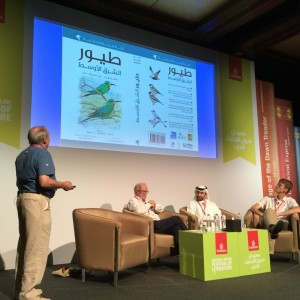The launch of the Arabic Birds of the Middle East
Richard Porter tells of how bee-eaters brings hope for wildlife
Early March and we are on the edge of the Arabian Gulf, the strong sunlight sparkling on the khors, mangroves, deserts and Dubai’s dramatic skyline. I am at the annual Emirates Festival of Literature to talk about bird conservation in the Middle East, take a wildlife walk for children and, especially, to launch the Arabic Birds of the Middle East. With its cover of colourful Blue-cheeked Bee-eaters – a widespread and familiar migrant in the Middle East – we hope it will encourage a new generation of Arabs to love birds.

Dubai’s skyline over the internationally important Ras al Khor where we saw over 10 globally threatened Greater Spotted Eagles.
This long awaited Arabic guide was born from Bloomsbury’s Birds of the Middle East and was welcomed at the Festival by an enthusiastic audience of many nationalities. Co-written with the late Simon Aspinall it was translated by Abdulrahman Al-Sirhan Alenezi of Kuwait, one of Arabia’s leading ornithologists. Such is his commitment to conservation, that he made the translation as a personal voluntary contribution to our understanding of birds. A translation of this magnitude with all the challenges of technical terms and Arab bird names is not for the feint-hearted and we owe a great debt of gratitude to Abdulrahman.
Bloomsbury generously made the rights freely available to the book’s publishers, BirdLife International and the Ornithological Society of the Middle East under the banner of Bloomsbury’s ‘Helm Field Guides’.
Sponsorship came from several organisations: OSME and RSPB, but also the journal British Birds, the Hima Fund and AviFauna. All were delighted to be part of a field guide that will promote an interest in birds and wildlife in a part of the world where good news is often rare.
As I have said before on a Bloomsbury blog, field guides to birds are only one cog in the conservation journey, enabling us to identify, quantify – and appreciate – the wonders of our natural world. For my generation these guides are books, but for the children of today it will increasingly be eBooks and Apps.
And an App is what OSME and BirdLife plan to produce next for the many Smartphone-carrying young Arabs who aspire to be the next generation of Middle East conservationists.
Birds of the Middle East is a completely revised second edition of the bestselling field guide to the birds of the Middle East, covering Turkey, Cyprus, Syria, Lebanon, Israel, Jordan, Iraq, Iran, the Arabian peninsula and Socotra.
Images provided by Richard Porter and Mark Smiles, do not reuse without permission.




